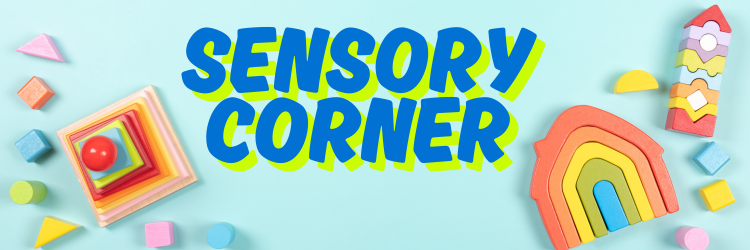Joeten Kiyu Public Library Family Sensory and Engagement Corner Policy

Preamble: Recognizing and Responding to Sensory Diversity
Our library is committed to fostering an inclusive environment where all children can engage with resources and programs comfortably and effectively. We recognize that a significant portion of the population, particularly children aged 0-12, experiences sensory sensitivities. These sensitivities can be associated with various conditions, including autism spectrum disorder (ASD), attention-deficit/hyperactivity disorder (ADHD), anxiety disorders, sensory processing disorder (SPD), and other developmental or neurological differences. For these children, typical library environments, with their potential for bright lights, sudden noises, and crowded spaces, can be overwhelming and hinder their ability to learn, explore, and enjoy the library’s offerings.
In response to this need, we have established the Library Sensory Corner as a dedicated space designed to provide a tranquil and secure haven. This thoughtfully designed area aims to minimize sensory input and offer tools and features that promote emotional regulation, relaxation, and a sense of calm. By creating this specialized environment, we endeavor to support the well-being and engagement of children with sensory needs, ensuring they have equitable access to the enriching experiences our library provides. The Sensory Corner underscores our commitment to creating a welcoming and accepting space for every member of our community. Priority for the use of this valuable resource will be consistently given to children who experience sensory sensitivities, ensuring it remains readily available to those who benefit most from its unique features.
Eligibility for Sensory Corner Access:
The Library Sensory Corner is intended to serve children within a specific age range and those who would genuinely benefit from a low-stimulation environment. To ensure its effective use and accessibility for those with the greatest need, the following guidelines for eligibility have been established:
- Age Appropriateness: The Sensory Corner is primarily designed for children aged 0 to 12 years. This age range encompasses the developmental stages where sensory sensitivities are often most pronounced and where a calming environment can have a significant positive impact.
- Demonstrated Need for Low-Stimulation: While the Sensory Corner is open to all children within the specified age range, priority for its use will be consistently extended to children who exhibit or have been identified as having sensory needs. This includes children with diagnosed conditions such as autism, ADHD, anxiety disorders, and sensory processing disorder, as well as children who simply demonstrate a need for a calmer, less stimulating environment as determined by their caregiver.
- Mandatory Caregiver Accompaniment and Supervision: For the safety and well-being of all children, and to ensure the appropriate use of the Sensory Corner, continuous and direct supervision by a responsible caregiver is mandatory. The caregiver must be at least 16 years of age and capable of understanding and enforcing the Sensory Corner policies. The caregiver is responsible for the child’s behavior and ensuring respectful interaction with the space and its contents. This is not a drop-off zone, and unsupervised children will not be permitted to remain in the Sensory Corner.
Detailed Supervision Guidelines:
The presence and active engagement of parents/guardians/caregivers are crucial to the successful and safe operation of the Sensory Corner. The following supervision guidelines outline the responsibilities of accompanying adults:
- Constant Presence: Parents/guardians/caregivers must remain within the Sensory Corner itself or in close proximity to the area, maintaining visual and auditory contact with the child at all times. This ensures immediate intervention if needed and allows for ongoing support and guidance. Loitering outside the immediate vicinity while a child is in the Sensory Corner is not permitted.
- Active Engagement (Not Passive Observation): Supervision entails more than simply being present. Parents/guardians/caregivers are expected to actively engage with the child, guiding their use of the sensory tools, ensuring they are interacting appropriately with the equipment, and being attentive to their needs and comfort levels. This active involvement helps maximize the benefits of the Sensory Corner and prevents misuse of the resources.
- Non-Delegation of Responsibility: The responsibility for supervision cannot be delegated to library staff or other individuals. Library staff are available to offer assistance with the space, answer questions about the policy, and address any maintenance concerns, but they are not responsible for the direct supervision of children within the Sensory Corner.
- Addressing Behavioral Issues: Parents/guardians/caregivers are solely responsible for managing their child’s behavior within the Sensory Corner. If a child becomes disruptive, disregards the usage rules, or engages in unsafe behavior, the caregiver must intervene promptly and appropriately. If the behavior cannot be effectively managed, the caregiver may be asked to conclude their session in the Sensory Corner.
Comprehensive Features and Equipment Inventory:
The Library Sensory Corner is equipped with a variety of carefully selected items designed to engage different senses in a calming and therapeutic manner. The specific features and equipment available may evolve over time based on user feedback and best practices in sensory support. Examples of items that may be included are:
- Tactile Sensory: Fidget Spinner, Sea Foam Putty, Spikey Bracelet, Snap Band, Fidget Popper, Puffer Ball Minion, Foam Stress Balls, Noodle String, Foam Building Blacks, Isoflex Stress balls, Base Plate, Slime, Clay, Fidget Pen, Pop It, Blue’s Clues Puzzle, Human Body Puzzle, Solar System Puzzle, Construction and Number Maze, Pin Art, Slinky, Jungle Maze, Railway Bucket Builder Set, Creative Peg Puzzle, The Workbench, Magnetic Chalk/Dry Eraser Board, Geometric Stacker, Stacking Wonder Blocks, Blue’s Clues Cube Blocks, Chunky Alphabet Puzzle, Geo Twister, Jungle Adventure Railway Table, Chunky Math Numbers Puzzle, Led light Switch Busy Board, Block Shape Holster, Children’s cleaning tools, Step Up Bamboo Easel, Counting Stacker, Chunky Clock Puzzle, Explore and Learn Magic cube, Colours and Shapes Stacker, Monster Math Scale, Shack and Match Shape Sorter, Hape Pop Up Shop, Chunky Alphabet Puzzle, Pyramid Of Play Staple Pyramide, Take Along Activity Box, Magic Forest Puzzle, Little Chef Cooking+Steaming Playset, Cupcake stackable Playset, Roller Derby, Double Rainbow Stacker, Dinosaur Puzzle, Cooking Essentials Starter Set, Pound and Tap Bench, All in One Kitchen, Nutty Squirrel Railway, Match and Roll Shape Sorter, Maple Blocks, Rocket Ball Air Stacker, Giant ABC Stack Blocks, Giant 123 Stack Blocks, Counting Stacker, Little Tikes Animal Zoo Bingo, Blue’s Clues Stacking Rainbow Block Puzzle, Build Me Up Stackable Blocks, ABC Wooden Blocks, Blue’s Clues chunky Puzzle, Whac-a-Mole Match-a-Mole, Master Workbench, Fast Food Toy Food Set, Breathing Balls, Geometric Puzzle, Slinky, Jack in the Box, Ball Pits, Children’s Tent, Assorted Jigsaw Puzzles, Paint, Crayons, Markers, Coloring Sheets, Inflatables, Magnetic 3D Tile Set, pop it toys, fidget spinners, Lil’ Tikes Work Bench, Sensory Carpet, Weighted blanket.
- Auditory Sensory: Light N Sound Stacker, Crinkle N Connect, Pop Tubes, Rainbow Xylophone, Mighty Mini Band, Pound and Tap Bench, Junior Percussion Set, Noise Cancelling Headphones, Floor Pianos.
- Visual Sensory: Light N Sound Stacker, Teaching Logarithmic Board, Twist and Turnables, Magnetic Art Box, Jungle Maze, Glow Stick, Led light Switch Busy Board, Block Shape Holster, Lava Lamp, STEM Marble Run Blocks for Kids, Sign Language Poster.
- Kinetic Sensory: Kinetic Sand, Atom Balls, Slime, Putty, Clay, Pin Art.
- Mobility aids: shopping carts, wheelchair, and crutches.
All items within the Sensory Corner must remain in the designated space to ensure their availability for all patrons. Additionally, all equipment and materials must be used respectfully and appropriately, in a manner consistent with their intended purpose and the overall goal of maintaining a calm and therapeutic environment. Parents/guardians/caregivers are responsible for ensuring their children use the resources responsibly and refrain from any actions that could damage or misuse the equipment.
Detailed Usage Rules: Fostering a Respectful and Tranquil Atmosphere
To ensure that the Sensory Corner remains a beneficial and accessible space for all patrons, the following detailed usage rules must be strictly adhered to:
- Proper Hygiene and Attire: An acceptable standard of personal hygiene is expected of all individuals. Unpleasant body odor, which may offend other individuals in the library, is considered unacceptable. Any substance like grease, ink, oil, etc., that can be transferred to other patrons, library furnishings, or equipment will not be permitted in the Sensory Corner. JKPL observes the common no shirt, no shoes, no service policy. In addition, patrons will not be permitted to wear inappropriate, suggestive, vulgar, or excessively revealing clothing not conducive to community standards. Sweat-soaked athletic or other clothing or offensive odor that disturbs other patrons is also sufficient grounds to request the individual to leave the library. It is not the library’s intent to enforce a strict dress code, but if appearance/clothing or lack thereof is disruptive to staff or others, the person will be asked to either comply or leave the library.
- Hand Hygiene Procedures: All children and parents/guardians/caregivers are required to sanitize or wash their hands thoroughly both before entering and upon exiting the Sensory Corner. Hand sanitizer is readily available for this purpose. Parents/guardians/caregivers are requested to assist young children in complying with hand hygiene protocols.
- Illness Prevention Measures: Patrons are strictly prohibited from utilizing the Sensory Corner if their child is exhibiting any symptoms of illness. These symptoms include, but are not limited to, fever, cough, rhinorrhea, emesis, or diarrhea. Should a child become ill while within the designated space, parents/guardians/caregivers are to promptly vacate the area and notify staff. Furthermore, they should identify any materials that necessitate sanitization.
- Footwear Requirements: Clean socks must be worn at all times within the Sensory Corner.
- Maintaining a Quiet Environment: The Sensory Corner is intended to be a calm and peaceful space. Patrons are expected to maintain a quiet atmosphere by speaking in soft voices and refraining from loud conversations, shouting, or other disruptive noises. Electronic devices should be used with headphones at a low volume to avoid disturbing others.
- Prohibition of Food and Drinks: To maintain the cleanliness and integrity of the sensory materials and to prevent potential allergic reactions, food and drinks of any kind are strictly prohibited within the Sensory Corner.
- Discouraging Active or Rough Play: The Sensory Corner is designed for quiet engagement and relaxation, not for active or rough play. Running, jumping, wrestling, or any other forms of boisterous activity are not permitted. Parents/guardians/caregivers should redirect children engaging in such behaviors.
- Implementation of Time Limits (During Peak Usage): To ensure equitable access to the Sensory Corner, especially during busy library hours or periods of high demand, time limits for individual sessions may be implemented. The duration of these limits will be posted, and library staff will politely inform patrons when their allotted time is nearing its end. Parents/guardians/caregivers are expected to be mindful of these limits and cooperate with staff to allow other children the opportunity to use the space.
- Respectful Use of Materials: Patrons are expected to handle all sensory toys and equipment with care and respect. Items should not be thrown, forcefully manipulated, or taken outside of the Sensory Corner. Parents/guardians/caregivers should guide their children in the appropriate and gentle use of all resources.
Comprehensive Care and Cleanliness Expectations: Ensuring a Sanitary and Orderly Space
Maintaining a clean, safe, and orderly Sensory Corner is a shared responsibility. The following detailed expectations for care and cleanliness are essential:
- User Responsibility for Tidying: Patrons are strongly encouraged to actively participate in maintaining the space by returning sensory toys, fidget tools, and other items to their designated storage locations immediately after use. This simple act of tidiness helps keep the area organized and ensures that items are readily available for the next user.
- Caregiver Assistance in Clean-Up: Parents/guardians/caregivers play a vital role in assisting children with tidying up. They should guide and encourage their children to return items properly and ensure that the space is left in a neat and orderly condition before their departure.
- Reporting Damaged or Soiled Items: It is crucial to promptly notify library staff of any items that are found to be broken, damaged, or soiled. This allows staff to take appropriate action, such as removing damaged items for repair or replacement and cleaning or sanitizing soiled materials to maintain a healthy environment for all patrons.
- Staff Responsibility for Regular Maintenance: Library staff will conduct regular checks of the Sensory Corner to ensure cleanliness, safety, and the proper functioning of all equipment. This includes routine cleaning, disinfecting frequently touched surfaces.
Fostering Respect, Understanding, and Accessibility:
The establishment and successful operation of a Sensory Corner hinge on the fundamental principles of respect, understanding, and accessibility for all patrons. These principles serve as the bedrock upon which a positive and supportive environment can be built, catering to the diverse sensory needs and individual differences of children.
- Creating a Non-Judgmental and Inclusive Space: The Sensory Corner is more than just a collection of calming tools; it is intentionally designed as a sanctuary of inclusivity and profound understanding. Its very foundation rests on the unwavering acknowledgment and deep respect for the diverse needs and varied coping mechanisms exhibited by all children. Recognizing that each child navigates the world through their unique sensory experiences, the Sensory Corner embraces this neurodiversity without reservation. It is a strictly non-judgmental space, free from any implicit or explicit biases, where children can explore their sensory preferences and engage with calming resources without fear of scrutiny or evaluation. Patrons of this vital space are actively encouraged to cultivate a strong sense of empathy and develop a heightened awareness of the wide spectrum of sensory sensitivities that their peers may experience. This collective understanding fosters a culture of acceptance and mutual support, transforming the Sensory Corner into a truly welcoming and beneficial resource for every child who enters.
- Prioritizing Respect for Personal Space: Ensuring a comfortable and secure environment for every individual utilizing the Sensory Corner is paramount. To achieve this, a clear expectation of mindfulness and respect for the personal space of others is essential. This includes a conscious effort to avoid any form of physical contact without obtaining explicit permission beforehand. Maintaining a comfortable and appropriate physical distance is also crucial in creating a sense of safety and security. By adhering to these guidelines, patrons contribute to an atmosphere of trust and consideration, allowing everyone to engage with the Sensory Corner’s resources in a relaxed and uninhibited manner. This respect for personal boundaries not only enhances the individual experience but also strengthens the collective well-being of all who utilize this shared space.
Consequences of Policy Non-Adherence:
The aforementioned policies governing the utilization of the Sensory Corner have been carefully established with the paramount objectives of safeguarding the well-being, fostering a comfortable atmosphere, and ensuring equitable accessibility for every individual who seeks the unique benefits of this dedicated space. These guidelines are not arbitrary; rather, they are the foundational pillars upon which a positive and supportive environment for children with diverse sensory needs is constructed and maintained.
Therefore, instances of non-adherence to these clearly articulated policies carry potential ramifications. While the library staff is committed to understanding and addressing individual circumstances with sensitivity and discretion, repeated or significant deviations from these established guidelines will necessitate intervention. In such situations, and at the professional judgment of the on-duty library staff member, a suspension of an individual’s access privileges to the Sensory Corner will be enacted.
It is crucial to understand that the implementation of a temporary suspension is not intended as a punitive measure. Instead, it serves as a necessary step to uphold the integrity of the Sensory Corner as a safe, predictable, and supportive space for all patrons. This measure aims to address behaviors that may inadvertently disrupt the experience of others, compromise the intended therapeutic benefits of the environment, or pose potential safety risks. The ultimate goal remains to maintain a welcoming and inclusive environment where all children with sensory sensitivities can feel secure, supported, and empowered.
The library deeply values the cooperation of all patrons, including the children themselves and their accompanying parents/guardians/caregivers, in diligently upholding these policies. By working together and respecting the guidelines in place, each member contributes directly to the creation and preservation of a positive and inclusive library experience for the entire community. This collaborative approach ensures that the Sensory Corner can continue to serve as a valuable resource, providing a much-needed sanctuary for children with sensory needs to explore, learn, and thrive. We sincerely appreciate your understanding and commitment to these principles.

